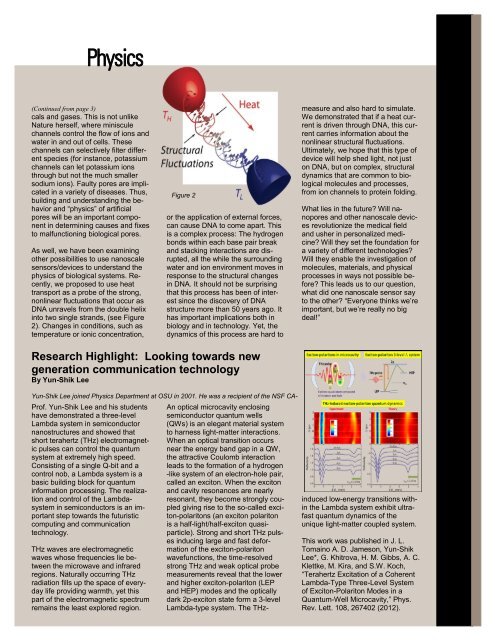Letter from the Chair - Physics at Oregon State University
Letter from the Chair - Physics at Oregon State University
Letter from the Chair - Physics at Oregon State University
You also want an ePaper? Increase the reach of your titles
YUMPU automatically turns print PDFs into web optimized ePapers that Google loves.
(Continued <strong>from</strong> page 3)<br />
cals and gases. This is not unlike<br />
N<strong>at</strong>ure herself, where miniscule<br />
channels control <strong>the</strong> flow of ions and<br />
w<strong>at</strong>er in and out of cells. These<br />
channels can selectively filter different<br />
species (for instance, potassium<br />
channels can let potassium ions<br />
through but not <strong>the</strong> much smaller<br />
sodium ions). Faulty pores are implic<strong>at</strong>ed<br />
in a variety of diseases. Thus,<br />
building and understanding <strong>the</strong> behavior<br />
and “physics” of artificial<br />
pores will be an important component<br />
in determining causes and fixes<br />
to malfunctioning biological pores.<br />
As well, we have been examining<br />
o<strong>the</strong>r possibilities to use nanoscale<br />
sensors/devices to understand <strong>the</strong><br />
physics of biological systems. Recently,<br />
we proposed to use he<strong>at</strong><br />
transport as a probe of <strong>the</strong> strong,<br />
nonlinear fluctu<strong>at</strong>ions th<strong>at</strong> occur as<br />
DNA unravels <strong>from</strong> <strong>the</strong> double helix<br />
into two single strands, (see Figure<br />
2). Changes in conditions, such as<br />
temper<strong>at</strong>ure or ionic concentr<strong>at</strong>ion,<br />
or <strong>the</strong> applic<strong>at</strong>ion of external forces,<br />
can cause DNA to come apart. This<br />
is a complex process: The hydrogen<br />
bonds within each base pair break<br />
and stacking interactions are disrupted,<br />
all <strong>the</strong> while <strong>the</strong> surrounding<br />
w<strong>at</strong>er and ion environment moves in<br />
response to <strong>the</strong> structural changes<br />
in DNA. It should not be surprising<br />
th<strong>at</strong> this process has been of interest<br />
since <strong>the</strong> discovery of DNA<br />
structure more than 50 years ago. It<br />
has important implic<strong>at</strong>ions both in<br />
biology and in technology. Yet, <strong>the</strong><br />
dynamics of this process are hard to<br />
Research Highlight: Looking towards new<br />
gener<strong>at</strong>ion communic<strong>at</strong>ion technology<br />
By Yun-Shik Lee<br />
Yun-Shik Lee joined <strong>Physics</strong> Department <strong>at</strong> OSU in 2001. He was a recipient of <strong>the</strong> NSF CA-<br />
Prof. Yun-Shik Lee and his students<br />
have demonstr<strong>at</strong>ed a three-level<br />
Lambda system in semiconductor<br />
nanostructures and showed th<strong>at</strong><br />
short terahertz (THz) electromagnetic<br />
pulses can control <strong>the</strong> quantum<br />
system <strong>at</strong> extremely high speed.<br />
Consisting of a single Q-bit and a<br />
control nob, a Lambda system is a<br />
basic building block for quantum<br />
inform<strong>at</strong>ion processing. The realiz<strong>at</strong>ion<br />
and control of <strong>the</strong> Lambdasystem<br />
in semiconductors is an important<br />
step towards <strong>the</strong> futuristic<br />
computing and communic<strong>at</strong>ion<br />
technology.<br />
THz waves are electromagnetic<br />
waves whose frequencies lie between<br />
<strong>the</strong> microwave and infrared<br />
regions. N<strong>at</strong>urally occurring THz<br />
radi<strong>at</strong>ion fills up <strong>the</strong> space of everyday<br />
life providing warmth, yet this<br />
part of <strong>the</strong> electromagnetic spectrum<br />
remains <strong>the</strong> least explored region.<br />
Figure 2<br />
An optical microcavity enclosing<br />
semiconductor quantum wells<br />
(QWs) is an elegant m<strong>at</strong>erial system<br />
to harness light-m<strong>at</strong>ter interactions.<br />
When an optical transition occurs<br />
near <strong>the</strong> energy band gap in a QW,<br />
<strong>the</strong> <strong>at</strong>tractive Coulomb interaction<br />
leads to <strong>the</strong> form<strong>at</strong>ion of a hydrogen<br />
-like system of an electron-hole pair,<br />
called an exciton. When <strong>the</strong> exciton<br />
and cavity resonances are nearly<br />
resonant, <strong>the</strong>y become strongly coupled<br />
giving rise to <strong>the</strong> so-called exciton-polaritons<br />
(an exciton polariton<br />
is a half-light/half-exciton quasiparticle).<br />
Strong and short THz pulses<br />
inducing large and fast deform<strong>at</strong>ion<br />
of <strong>the</strong> exciton-polariton<br />
wavefunctions, <strong>the</strong> time-resolved<br />
strong THz and weak optical probe<br />
measurements reveal th<strong>at</strong> <strong>the</strong> lower<br />
and higher exciton-polariton (LEP<br />
and HEP) modes and <strong>the</strong> optically<br />
dark 2p-exciton st<strong>at</strong>e form a 3-level<br />
Lambda-type system. The THz-<br />
measure and also hard to simul<strong>at</strong>e.<br />
We demonstr<strong>at</strong>ed th<strong>at</strong> if a he<strong>at</strong> current<br />
is driven through DNA, this current<br />
carries inform<strong>at</strong>ion about <strong>the</strong><br />
nonlinear structural fluctu<strong>at</strong>ions.<br />
Ultim<strong>at</strong>ely, we hope th<strong>at</strong> this type of<br />
device will help shed light, not just<br />
on DNA, but on complex, structural<br />
dynamics th<strong>at</strong> are common to biological<br />
molecules and processes,<br />
<strong>from</strong> ion channels to protein folding.<br />
Wh<strong>at</strong> lies in <strong>the</strong> future? Will nanopores<br />
and o<strong>the</strong>r nanoscale devices<br />
revolutionize <strong>the</strong> medical field<br />
and usher in personalized medicine?<br />
Will <strong>the</strong>y set <strong>the</strong> found<strong>at</strong>ion for<br />
a variety of different technologies?<br />
Will <strong>the</strong>y enable <strong>the</strong> investig<strong>at</strong>ion of<br />
molecules, m<strong>at</strong>erials, and physical<br />
processes in ways not possible before?<br />
This leads us to our question,<br />
wh<strong>at</strong> did one nanoscale sensor say<br />
to <strong>the</strong> o<strong>the</strong>r? “Everyone thinks we’re<br />
important, but we’re really no big<br />
deal!”<br />
induced low-energy transitions within<br />
<strong>the</strong> Lambda system exhibit ultrafast<br />
quantum dynamics of <strong>the</strong><br />
unique light-m<strong>at</strong>ter coupled system.<br />
This work was published in J. L.<br />
Tomaino A. D. Jameson, Yun-Shik<br />
Lee*, G. Khitrova, H. M. Gibbs, A. C.<br />
Klettke, M. Kira, and S.W. Koch,<br />
“Terahertz Excit<strong>at</strong>ion of a Coherent<br />
Lambda-Type Three-Level System<br />
of Exciton-Polariton Modes in a<br />
Quantum-Well Microcavity,” Phys.<br />
Rev. Lett. 108, 267402 (2012).
















